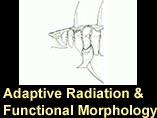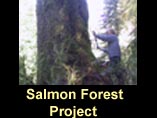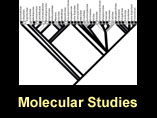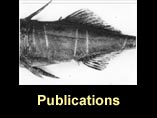





 |
 |
 |
 |
 |
 |
|---|
Tree rings and historical signatures of salmon
T. E. Reimchen
Conifer trees adjacent to salmon rivers on the west coast of
North America incorporate marine-derived nitrogen from the carcasses of
salmon carried into the forest by bears and other scavengers. We demonstrated
(Reimchen et al. 2003) that small samples of wood (30 mg) extracted
from cores of ancient trees contain detectable levels of 15N. Comparisons
among watersheds differing in number of salmon show that 15N levels
in wood of trees are directly proportional to the present numbers of salmon
entering the streams. Comparisons within watersheds along a sharp gradient
in salmon density also show a strong positive correlation with 15N levels
in  trees
and salmon density. Historical fluctuations in 15N levels extracted
from yearly growth rings of trees show significant tracking with salmon
escapement over the last 50 years for some trees yet no association for
other trees that occur within the same microhabitat. Within watersheds,
larger and older trees exhibit higher 15N levels than small trees from
the same habitat. Among trees with major access to salmon carcasses, up
to 75% of the total nitrogen in the tree appears to be derived from salmon
nutrients. Our detection of 15N levels in yearly growth rings of
trees using small quantities of wood from standard increment cores offers
a novel tool for assessing the occurrence and potentially the relative
abundance of salmon and other anadromous fish in past centuries from watersheds
of North America, Europe and Asia and has applications for any regions
with ancient trees near marine habitats. Collaborators on this project
include Dr. D. Harris (UC Davis), D. Mathewson, C. Fox and H. Bryan.
trees
and salmon density. Historical fluctuations in 15N levels extracted
from yearly growth rings of trees show significant tracking with salmon
escapement over the last 50 years for some trees yet no association for
other trees that occur within the same microhabitat. Within watersheds,
larger and older trees exhibit higher 15N levels than small trees from
the same habitat. Among trees with major access to salmon carcasses, up
to 75% of the total nitrogen in the tree appears to be derived from salmon
nutrients. Our detection of 15N levels in yearly growth rings of
trees using small quantities of wood from standard increment cores offers
a novel tool for assessing the occurrence and potentially the relative
abundance of salmon and other anadromous fish in past centuries from watersheds
of North America, Europe and Asia and has applications for any regions
with ancient trees near marine habitats. Collaborators on this project
include Dr. D. Harris (UC Davis), D. Mathewson, C. Fox and H. Bryan.